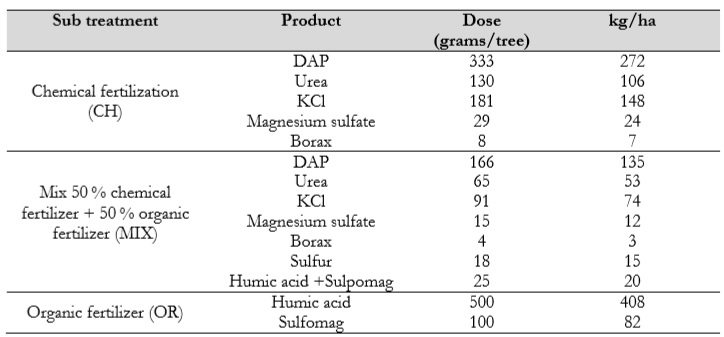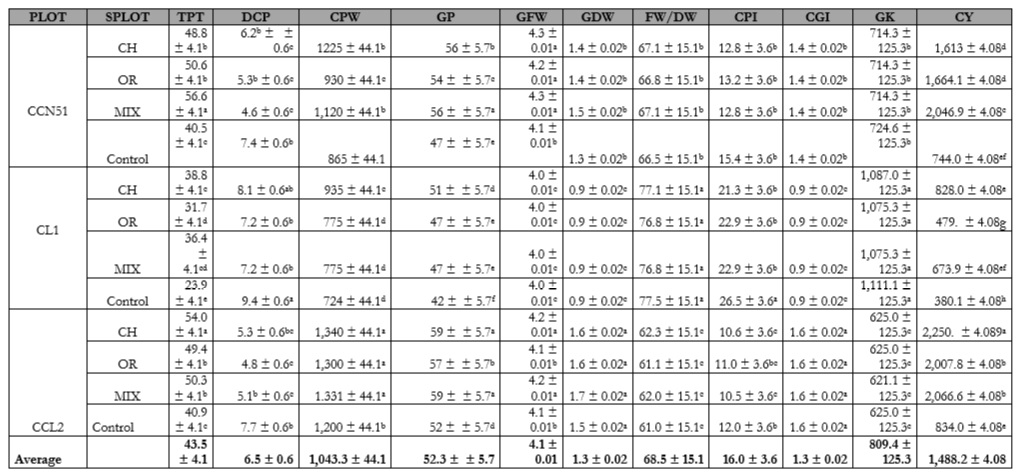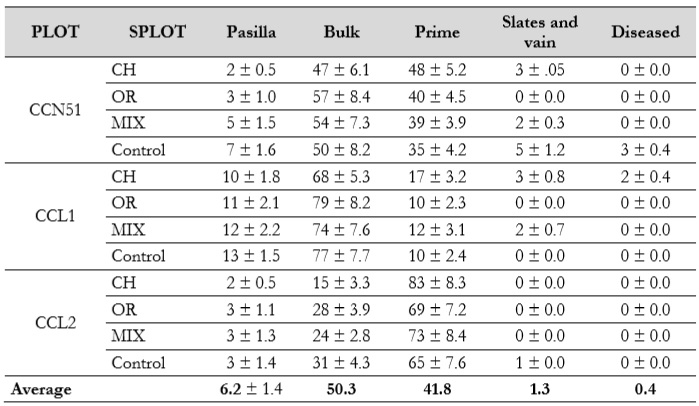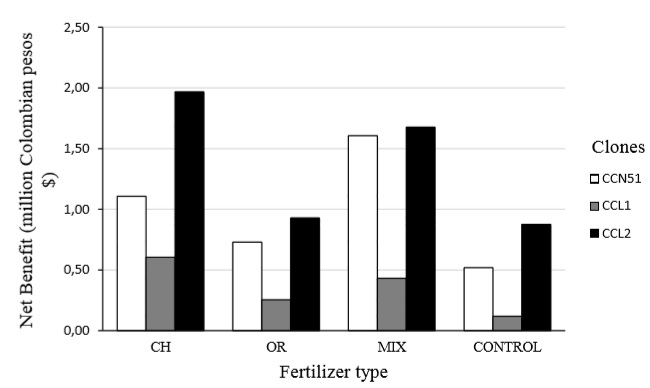Introduction
The cacao tree, Theobroma cacao L. (Malvaceae), is a cosmopolitan commodity crop native to South America (Zhang et al., 2009). In Colombia, the average yield is 0.43t/ha (FEDECACAO, 2020); this value is close to the world average, which is low considering production costs. These low yields are due mainly to diseases such as frosty pod rot (Moniliophthora roreri (Cif and Par) Evans et al.) and witches’ broom (Moniliophthora perniciosa (Stahel) Aime & Phillips-Moray) (Dantas-Neto et al., 2005; Phillips-Mora et al., 2007), low level of technology (Sánchez-Mora & Garcés-Fiallos, 2012), and the aging of cacao trees that do not get replaced (FEDECACAO, 2020).
In the Nariño province, especially the Tumaco municipality, these constraints have reduced yields to 0.29 t/ha (Agronet, 2020). It is a significant technological gap, far away from the break- even point (1.5 t/ha) (Quintana Castelblanco et al., 2015). However, the cacao from Tumaco is recognized in international markets for its superior flavor and aroma (FEDECACAO, 2020). Unfortunately, this comparative advantage does not impact farmers’ value chains due to their low yields.
High cacao yields are possible using superior cacao clones, best agricultural practices (FEDECACAO, 2016), and proper agronomic management (De Olivera et al., 2015, FEDECACAO, 2016). Studies from Castellanos et al. (2007), Pérez (2009), Rosas et al. (2017), and Sanchez-Mora et al. (2014) report cacao yields above the break-even point suggested by Quintana Castelblanco et al. (2015). Thus, in medium-technology plantations, yields range between 500 and 1,000 kg/ha (DANE, 2004), whereas in high-technology farms, it is between 1,000 and 3,000 kg/ha/year; as noted by Puentes (2018), high-tech farms yields even exceed 2,000 to 3,000 kg/ha/year. Of course, the break-even point is correlated with the technological level applied to the farm.
These high yields result from best management practices, including fertilizer applications (Puentes-Páramo et al., 2016; Rosas et al., 2017; Ruales et al., 2011). However, defining the optimal nutritional levels to increase yields substantially requires a careful study of the needs of the crop and the nutrients available in the soils (Ruales et al., 2011). Since crop productivity is increased through fertilizers, a careful use is required to guarantee soil health and environment sustainability (Tezara et al., 2016) and contribute to reducing global greenhouse, gases carbon footprint (Grassi et al., 2021).
Unfortunately, fertilizers are applied to cacao crops as recipes in Colombia without analyzing soil characteristics, climate, environmental conditions, or nutrient balance. This peculiar condition causes uncertainties and inadequate fertilizer usage. Likewise, in Colombia, especially Tumaco, few studies focus on cacao nutrition (Puentes et al., 2014).
The local scientific research about the genetic and physiological performance of cacao clones in different sites and management regimes is even more scarce. This picture poses many uncertainties about the feasibility of cacao crop investments despite their comparative advantages (Ferraris et al., 2016). Therefore, this research aims to analyze the effect of organic and mineral fertilization on the yield of cacao clones in an agroforestry system in Southwest Colombia, at Rescate Las Varas Community Council, Tumaco, Nariño.
Materials and methods
The research was carried out in the clonal garden of the Cortepaz farmers’ organization located in the San Luis Robles Village, Tumaco, Nariño, in Southwest Colombia, under an average temperature of 27 °C, relative humidity of 80%, precipitation of 2,800 mm/year, and sunlight of 1,008 hours/year (IDEAM, 2017). The experimental area is in the tropical humid forest life zone (bh-T) (Holdridge, 1982).
Experimental Site
The field plot had grafted cacao plants where the upper parts (scions) were from regional and universal clones and the root system (rootstock) from TSH 565 cocoa clone. Under an agroforestry arrangement, the trees were planted at 3.5 x 3.5 m (816 trees/ha). At the evaluation time, they were seven-year-old, four meters high, and 30% shaded by Cedella odorata trees.
Experimental Design
We used a randomized complete block design in a split-plot factorial arrangement, with 12 treatments and three replications. The whole plot encompassed three clones, CCN51, regional CCL1, and regional CCL2 grown in a double row. These plots were split into four subplots to apply different chemical and organic fertilizer doses (table 1). A cacao plant row separated experimental units to avoid a border effect. The statistical model used is described by equation 1.
Where: Yijk = variable response in the block i, whole plot j (cacao clones), and subplot k (fertilizer doses); μ = general mean, ρ = effect of block i, α = effect of the whole plot treatment j (cacao clones), δij= random component of the large plot, β = effect of fertilizers k, (αβ)jk = cacao x fertilizers interaction, єijk = experimental error.
Soil Samplings
We took soil samples at 20 cm depth and analyzed them in the soil laboratory of the Universidad de Nariño to calculate fertilizer doses; the results are shown in table 2. The final doses consisted of balancing soil analysis outcomes and the cacao mineral uptake to yield 1.5 t/ha of dry cacao grains (Puentes-Páramo et al., 2014). The organic fertilizer doses were calculated in the same way. Six months before fertilization, one ton/ha of lime was applied to reduce soil acidity. The doses of fertilizer were added at 1.5 m from the base of the stem.
Table 1 Fertilization and composting regimes applied to the different clones

NoteDAP (di-ammonium phosphate) = Total nitrogen 18%, phosphorus 46%, sulfur 1.1%, magnesium 0.9%, humidity ≤ 0.50%; UREA = nitrogen 46%; KCL = potassium chloride 60%; MAGNESIUM SULFATE = phosphorus 3%, calcium 4%, magnesium 20%, sulfur 9%, silicon 18%; BORAX = 15%; HUMIC ACID = humic acid 88%, potassium oxide 11–13%; SULFOMAG = potassium 22%, magnesium 18%, sulfur 21.5%, chloride 2.5%.
Source: Elaborated by the authors.
Cacao Crop Management
The experimental plot was managed homogeneously for two years, cleaning weeds every three (3) months, fertilizing every four (4) months, pruning every six (6) months, and controlling diseases as frosty pod rot every fifteen days and witches’ broom every three (3) months. According to the soil analysis (table 2), the doses of both organic and chemical fertilizers were applied quarterly. The first application was eight months before the main harvest; these applications were made in crown or half-crown according to the topography of each microsite. The second year’s response variable yield was measured to avoid bias to reflect the actual fertilization effect.
Variables Evaluated
Total of pods per tree, number of healthy and affected pods, pods weight, grains per pod, fresh and dry grain weight, grains fresh and dry weight ratio, grain (seed) index, pod index, and quality parameters of the grains according to the ICONTEC standards (2012).
Statistical Analysis
Once the data normality assumptions were met, we carried out an analysis of variance. The variables that showed statistical differences were subjected to Duncan’s multiple range test with a probability of 95%. Data were processed with SAS 9.4 SAS software (Institute Inc., Cary, NC). The statistical results of the yield response variable underwent a partial budget economic analysis (CIMMYT, 1988).
Results and discussion
Total Pods Per Tree (TPT)
The ANOVA showed significant statistical differences (P > 0.0001) in the interaction between fertilizer and cacao clones (Table 3). Duncan’s multiple range tests indicated both the CCL2 regional cacao and CCN51 clone reached the highest number of healthy pods per tree, 54 and 56.6 pods/tree, respectively, the first with chemical fertilization and the second with a mixture of chemical and organic fertilizers at a 50% rate.
Table 3 Response of different agronomic variables from cacao clones subjected to different fertilization regimes in Tumaco Nariño Colombia

NoteMeans with the same letter by column do not show statistically significant differences. PLOT = main plot (treatments), SPLOT = split-plot (sub treatments), TPT = total pods per tree, DCP = diseased cacao pods, CPW = cacao pod weight (g), GP = grains per pod, GFW = grain fresh weight (g), GDW = grain dry weight (g), FW/DW = fresh and dry weight ratio (%), CPI = cacao pod index; CGI = cacao grain index, GK = dry grains per kilogram, CY = cacao yield (kg/ha), CH = chemical fertilization, OR = organic fertilization, MIX = chemical and organic fertilizers mixture.
Source: Elaborated by the authors
Bonilla et al. (2014) reported 7.55 pods/tree/year production, with a maximum peak in the third year of 17 pods. Perea et al. (2017) reported 17 and 19 pods in another study. Escobar (2008), with the clone CCN51, found 64 pods, applying 150 g/tree of NPK fertilizer. This variability in pods might be related to the genetic characteristics of the cacao genotypes, the environment (Phillips et al., 2012), and ecological factors (Niether et al., 2017). The response variable healthy pods per tree is not the best indicator. Although it is a crucial yield index, the quantity and weight of grains are the most relevant to farmers (Sánchez Mora et al., 2014). In this study, these two clones exceeded the results of most cacao fertilization studies, being an indicator of the potential of these two clones.
Diseased Cacao Pods (DCP) Per Tree
There were significant statistical differences (P > 0.0001) in the interaction between fertilizer sources and cacao clones. In the unfertilized clones, most pods were affected by Moniliophthora roreri (frosty pod rot) (average 6.5 pods/tree). The CCL1 regional cacao without fertilization reached the higher number of diseased pods (9.4 pods/tree) with significant differences with the other treatments. Considering the number of pods affected by these diseases, it can be inferred that approximately 500 g of dry cacao per tree is lost yearly, equivalent to 500 kg/ha. This disease is critical and limits cacao production in Latin America (Grisales & Afanador, 2007; Phillips- Mora et al., 2005, 2007;).
Likewise, M. roreri is responsible for more than 50% of cacao yield losses in low technology farms (Sánchez et al., 2003; Sánchez-Mora & Garcés-Fiallos, 2012). On the other hand, Moniliophthora perniciosa (witches’ broom) causes significant economic losses in all cacao growing regions; in some cases, it has caused yield reductions ranging from 50 to 90% of the harvest (Almeida et al., 2014; Meinhardt et al., 2008). Thus, the spread of these two diseases threatens all cacao-producing countries (Tirado-Gallego et al., 2016). M. roreri and M. perniciosa cause significant losses than those produced by Phytophthora (Dantas-Neto et al., 2005). Therefore, controlling these two diseases is fundamental for cacao yield increase.
Cacao Pod Weight (CPW)
In the ANOVA, there were significant statistical differences (P > 0.0001) in the interaction between fertilizer sources and cacao clones. The CCL2 regional cacao with the chemical fertilization and the mixture of chemical fertilization and 50% organic fertilizer reached the highest pod average weights.
Phillips et al. (2012) reported a fresh pod weight of 566.1 g, values lower than those found in this study, probably caused by climatic conditions such as the rainy season and the genetics of these materials. Puentes-Páramo et al. (2014) pointed out that the treatment with the highest pod weight had the highest concentration of K in the soil. The same phenomenon was evident in this research, obtaining a higher average pod weight in treatments fertilized with 181 g/plant of K (Table 3). However, most of the pod weight share comes from the husk. This clones’ response could be helpful to obtain by-products from the husk (Soares & Oliveira, 2022). These results prove that K is essential for cacao yield because it is a very mobile mineral responsible for solutes transport to different plant structures. López et al. (2015) affirm that K is the element that the tree absorbs the most, followed by N, Ca, and Mg.
Pod Grains (PG)
There were significant statistical differences (P > 0.0001) in the interaction between fertilizer sources and cacao clones. The CCL2 regional cacao, with the application of chemical fertilization and the mixture of chemical and organic fertilizers, reached the highest number of grains per pod. Evaluations in cacao clones carried out by Phillips et al. (2012) reported between 30 and 35 grains per pod. ± This study obtained an average of 52.3 ± 0.66 grains per pod (table 3) with chemical fertilization. The outcomes were 51, 56, and 59 grains per pod in the clones CCL1, CCN51, and CCL2, respectively, values much higher than those recorded by Phillips et al. (2012).
Grain Fresh Weight (GFW)
The ANOVA showed significant statistical differences (Pr > 0.0001) in the interaction between fertilizer sources and cacao clones. The CCN51 clone with the sub treatments of chemical application and the mixture of chemical fertilization and 50% organic fertilizer and the CCL2 with the chemical fertilization and the mixture reached the highest fresh weight of pod grains ranging between 4.2 and 4.3 g.
Grain Dry Weight (GDW)
There were significant statistical differences (Pr > 0.0001) in the interaction between fertilizer sources and cacao clones. The CCL2 regional cacao in all fertilization regimes, including the control, reached the highest average dry weight of grains with 1.6 g.
The differences between seed weights are probably due to the genetic characteristics of the clones and the effect of fertilizers applied, as corroborated by Sánchez Mora et al. (2014). They pointed out the number of grains per pod and their weight is affected by genetics, water and nutrient availability, and tree location.
Fresh and Dry Grain Weight Ratio (FW/DW)
In the relationship between fresh weight and dry weight of cacao beans, there were significant statistical differences (Pr > 0.0001) in the interaction between fertilizer sources and cacao clones. We established that the CCL1 regional cacao in all fertilization regimes and the control reached the lowest fresh/dry weight ratio (table 3). It indicates that the CCL1 clone and the unfertilized treatments presented with the least mucilage. The other treatments deserve more study because they may have a good potential as a producer of alcohol and acetic acid, some by-products in the cacao grains fermentation process (Braudeau, 2001). The mucilage, which is usually a waste, is industrialized in Brazil, Costa Rica, and Colombia (Vallejo Torres et al., 2016). Those results gain relevance considering that 100 kg wet unfermented cacao produces approximately 40 kg of dry beans (Bharath & Bowen-O’Connor, 2008).
Cacao Pod Index (CPI)
There were significant statistical differences (Pr > 0.0001) in the interaction between fertilizer sources and cacao clones. The CCL1 clone and the control needed more than 20 pods to complete one kilogram of dry cacao; the best index was reached with the CCL2 clone in the different doses of fertilizers and compost.
Perea et al. (2017) established 20 pods per kg for clone CCN51. When studying 26 promising clones for Colombia, the same authors reported a pod index ranging from 11 to 25 pods. Soares & Oliveira (2022) obtained an interval between 14 to 17 and for ICS 60, an interval between 12 to 17 pods per kg. In this research, these values ranged between 10 and 23 pods, the clone CCL2 having the best index with an average of 11 pods per kg (table 3).
Grain Index (GI)
In this variable defined as the average weight of dry cacao beans, there were significant statistical differences (P > 0.0001) in the interaction between cacao clones and fertilization regimes. The CCL2 showed the highest cacao grain indices with 1.6 g. These values did not show differences with the other fertilizer sources; the lowest values were found in CCL1 with 0.9 g.
The grain index required by industries must be greater than one gram (1 g) (ICONTEC, 2012; Phillips et al., 2012). It table 3 shows that except for clone CCL1, all cacao clones exceed this index, with significant differences in favor of the CCL2 clone. These values were higher than those reported by Bonilla et al. (2014), who recorded values between 1.18 and 1.29 g. Quintana Gomez et al. (2015) determined an average grain index of 2.3, 1.6, and 1.3 g for clones ICS60, CCN51, and ICS 95, respectively. There is high variability in this index, depending on cacao genetics. Therefore, the CCL2 clone analyzed in this study has unique grain characteristics for industrial purposes, as indicated by ICONTEC (2012).
Grains per Kilogram (GK) of Dried Cacao
There were significant statistical differences (Pr > 0.0001) in the interaction between fertilizer sources and cacao clones in the analysis of variance. The separation of averages shows that regional cacao needs more cacao grains per kilogram of dry cacao, with values ranging between 621 and 1,111.1 grains per kilogram.
Cacao Yield (CY)
Cacao yields evidenced significant statistical differences (Pr > 0.0001) in the interaction between fertilizer sources and cacao clones. The CCL2 cacao, with the chemical fertilization mixture, reached the highest productivity of dry cacao with an average of 2,250 kg/ha. The CCL1 clone reported the lowest values in the control treatment (380.1 kg/ha) (table 3).
These results indicate that fertilization with any source positively affects cacao yield. It is considered that the number of pods has an important influence on this variable (Furcal- Beriguete, 2016) since the treatments that contained fertilizer obtained higher averages than the control. Bonilla et al. (2014) reported yields ranging from 825.6 to 1,167.53 kg of dry grain per ha, Sanchez-Mora (2014) found clone yields ranging from 1,154 to 1,820 kg/ha, Daymond et al. (2002) showed a varying yield ranging from 200 and 1,389.0 kg/ha, Pérez (2009) recorded a cacao yield of 1,441.0 kg/ha, whereas Sánchez-Mora et al. (2012), found productivity of 1,126.8 kg/ha.
This study attained an average yield of 1,488.2 kg/ha; therefore, the yields of the clones under different treatments exceeded the average productivity of the region of 300 kg/ha reported by Preciado et al. (2011) and 290 kg by Agronet (2020), and in some cases, it was higher than the break-even point of 1,500 kg/ha (Quintana Castelblanco et al., 2015). Therefore, to achieve yields with cacao clones close to this value reported by Quintana et al. (2015), it will be essential to apply fertilizers of organic or synthetic origin in proportions and quantities that allow the clones to express their genetic potential for a yield higher than the current one, at reasonable costs. In this way, the income of producers will improve (Castellanos et al. (2007).
In a cacao agroforest, obtaining high yields and their sustainability over time is related to climatic variables without neglecting crop management (Cueva, 2013). Under suitable climatic conditions and proper management, growth and yield respond favorably with the application of fertilizers (Cueva, 2013; López et al., 2007; Ruales et al., 2011). Ruales et al. (2011) found differences between fertilizer formulas (19-4-19, 15.5-0-0-26 (CaO), Kmag and KCl) and when compared to biological amendments (300 g/tree/year of humic acid plus 100 g of Sulfomag (k 26%, Mg 11%, S 20%). Organic amendments produced the lowest yields.
On the other hand, the CCN51 clone obtained yields like those reported by Cuenca-Cuenca et al. (2019). However, because of its inferior organoleptic properties, such as the high presence of acidity, astringency, and few floral, fruity, and nutty notes (Quintana Gomez et al., 2015), this type of cacao be only used as bulk cocoa to produce mass chocolate (Jimenez et al., 2017). It can be inferred that it is possible to further increase the productivity of this clone in Tumaco due to its high genetic potential (Boza et al., 2014). Unfortunately, the constraints cited above make consumers reject this clone (Machado et al., 2018; Perea et al., 2017), which leads farmers and traders to prefer certified clones with outstanding flavor and aroma characteristics (Machado et al., 2018; Scott, 2016).
Quality Parameters of Cacao Grains
In classifying the cacao beans from the sample, CCL2 cacao showed the highest amount of premium cacao with chemical fertilization (83%) and the lowest number of ordinary and low- quality cacao grains (table 4). These results indicate that this clone has outstanding quality parameters compared to the other two clones with lower values.
Cacao grains quality depends on genetic profile, environmental conditions, pod maturity, and fermentation processes (Calvo et al. 2021); however, fertilization played a vital role in the final cocoa grain quality parameters in this study.
Table 4 Quality parameters of cacao grains according to the Colombian standard (ICONTEC, 2012)

NotePLOT = Main plot (treatments), SPLOT = split-plot (sub treatments), CH = Chemical fertilization, OR = Organic fertilization, MIX = Mixture of chemical and organic fertilization
Source: Elaborated by the authors
Economic Analysis
The crop budgets by FEDECACAO (2013) at year seven (7) were COP 7,294,700, which, adjusted for Tumaco, added to $ 7,598,645 because of input’s transportation, wages, and soil drainages construction. The outcomes show that cacao clone CCL2 with chemical fertilization had the best performance (figure 1). In the analysis, CCN51, with the mixture of chemical and organic fertilization, had the highest net benefits, while for CCL1 and CCL2, their indicators only improved with chemical fertilization.

Source: Elaborated by the authors
Figure 1 Net benefit from the clones under different fertilizer doses. CH = Chemical, OR = Organic, MIX = Mixture of Chemical and Organic
In the marginal rate of return, CCN51, with the mixture of chemical and organic fertilizers, had the highest returns with 522.3% compared to CCL2 with chemical fertilization (470%). It means that for each peso the farmer invests in fertilizers, he recovers his investment with a surplus of COP 5.22 and COP 4.7 for CCN51 and CCL2 clones, respectively.
The hypothesis stated by Díaz et al. (2013) about not competitiveness of cacao farms in Tumaco is rejected with the outcomes of this study. We agree that these farms have a low technological level, aged trees, and are affected by M. rorery and M. perniciosa diseases (Djuideu et al., 2021). However, by using universal and regional clones with outstanding agronomic characteristics, regulating shade, and applying fertilizers (Tsufac et al., 2021) as proven in this study, the yield will increase significantly.
Many researchers have studied fertilization in cacao (T. cacao) crops to increase yield (Ruales et al., 2011; Morais, 1998; Rosas et al., 2017; Rosas et al., 2019; Uribe et al., 1998). Recalde et al. (2012) reported that the fertilization effect on cacao trees’ performance is evident. However, establishing optimal nutritional management requires efficient nutrients, as pointed out by Romero et al. (2016), since most fertilizers applied do not guarantee a higher yield (Puentes et al., 2014).
Cacao producers in Tumaco are sensitive to fertilizers but require training on their efficient use. Finally, for future research, the effect of fertilization on the aroma and flavor of regional cacao (Gil et al. 2019) and of cadmium and lead concentration on grains (Arévalo-Gardini et al., 2016) must be studied to avoid market concerns
Conclusions
The Theobroma cacao L. clones grown under agroforestry systems with 30% shading responded differentially to chemical and organic fertilization regimes, with an increasing trend in favor of clones CCN51 and CCL2.
The clones CCN51 and CCL2, with chemical fertilization, had the highest yield, while the clone CRI, without fertilizer, had the lowest. The outcomes of these two clones exceeded the break- even point.
The economic analysis showed that the fertilization of cocoa agroforests is a profitable practice because all treatments increased producers’ income compared with the traditional system.

















